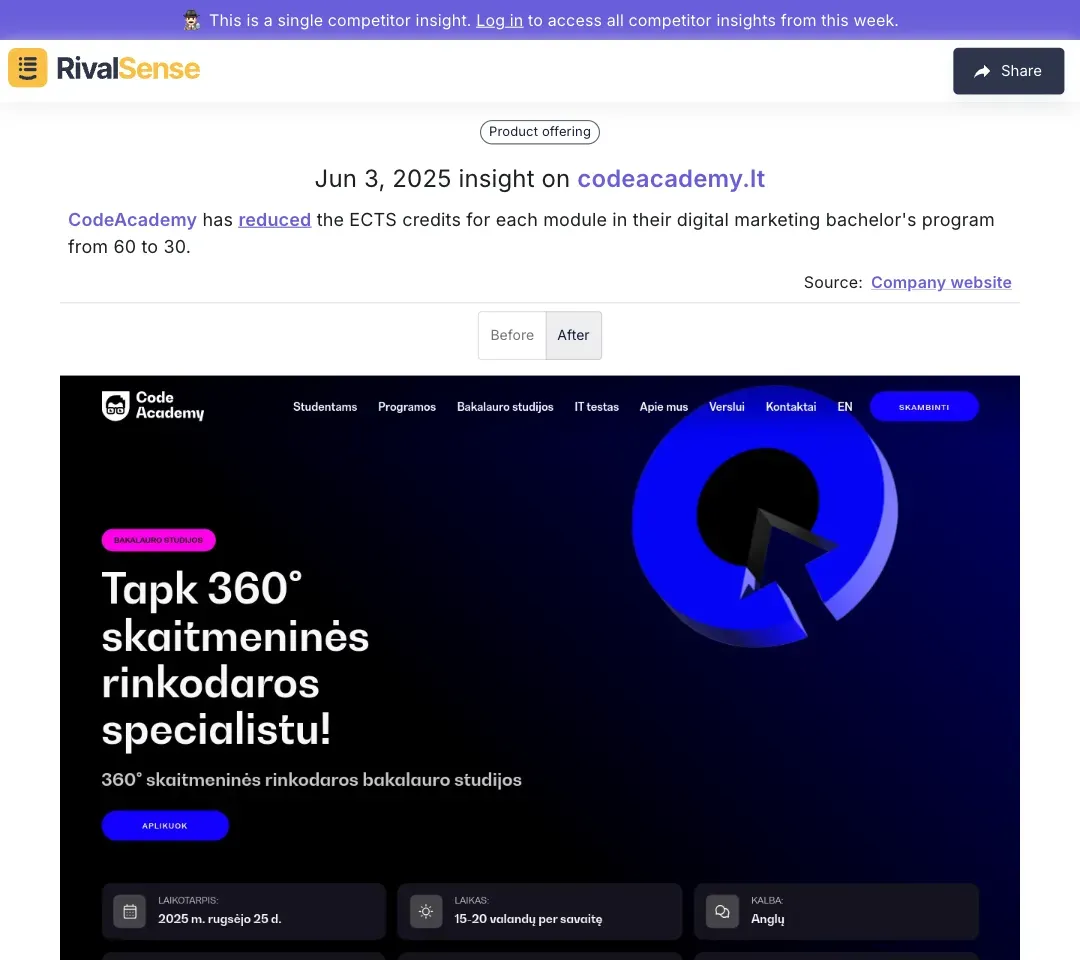How CodeAcademy's Credit Cut in Digital Marketing Fueled Competitors' Strategies
The online education sector thrives on constant innovation and shifting value propositions. Before CodeAcademy's pivotal change, it dominated with interactive courses across coding, data science, and digital marketing disciplines. Competitors like Udemy and Coursera operated in parallel lanes—marketplace models and university partnerships—without directly challenging CodeAcademy's core interactive learning niche. This equilibrium shifted dramatically when CodeAcademy reduced the educational value of its offerings, creating strategic openings for alert competitors.
Practical takeaways for business leaders observing such industry shifts:
- 🔄 Track competitor feature/pricing changes as early indicators of market disruption
- 🎯 Identify underserved customer segments created by competitor pivots
- ⚡️ Develop rapid-response playbooks for capitalizing on strategic gaps
✅ Opportunity Capture Checklist:
- Monitor competitor announcements through automated tracking
- Analyze sentiment in niche forums and social channels
- Align messaging with emerging customer pain points
- Prototype fast-turnaround offers for displaced users
The Catalyst: Analyzing CodeAcademy's Credit Cut Decision
Educational accreditation directly impacts learner outcomes and platform credibility. CodeAcademy's reduction of ECTS credits from 60 to 30 per module in their digital marketing bachelor's program fundamentally altered its value proposition. This strategic shift, captured in real-time by competitive intelligence platforms, triggered immediate learner dissatisfaction and market realignment.

Why this matters: Tracking competitor curriculum changes provides early warning of market vulnerabilities. These insights allow businesses to reposition offerings before customer migration peaks—turning observational data into acquisition opportunities.
The backlash manifested across platforms like Reddit and Twitter, with learners criticizing the diminished credential value. Competitors monitoring these signals quickly deployed counter-strategies:
- Extended free trials for accredited programs
- Bundled certification packages
- Transparent credit-comparison tools
🚀 Action Framework:
| Step | Tactic | Business Impact |
|---|---|---|
| Signal Detection | Track competitor feature changes | Identify market gaps within 48 hours |
| Sentiment Analysis | Monitor niche communities | Discover unmet needs for product positioning |
| Strategic Response | Launch targeted incentives | Capture churning customers within 1-2 weeks |
Strategic Response: How Competitors Seized the Opportunity
When accreditation value diminishes, learners immediately seek credible alternatives. Market-savvy competitors recognized CodeAcademy's credit reduction as a pivotal acquisition moment. Within days, platforms like Coursera and specialized marketing academies deployed multi-channel campaigns targeting displaced digital marketing students.
One competitor's rapid counter-moves included:
- Tiered Pricing Overhaul: Created entry-level accreditation bundles at 40% below CodeAcademy's revised pricing
- 'Credit Match' Guarantee: Promised equivalent ECTS recognition for transferred coursework
- Industry Partnership Boost: Collaborated with HubSpot and Google to enhance certification credibility
Key differentiators emphasized in their repositioning:
- 🎓 Industry-Recognized Credentials: Highlighted accreditation partners in marketing materials
- 🤝 Learning Communities: Launched mentor-matching and peer review systems
- 📈 Career Impact: Showcased salary-increase statistics for certified graduates
💡 Strategic Takeaways:
- Competitor missteps create 2-4 week acquisition windows—prepare response templates in advance
- Feature changes often precede customer churn—monitor them as leading indicators
- Partnerships multiply credibility during competitor trust crises
Execution and Growth: The Competitor's Path to Success
Rapid execution separated opportunistic reactions from strategic wins. The most successful competitor deployed a three-phase implementation:
Phase 1: Acquisition Surge (Weeks 1-2)
- Geo-targeted ads to CodeAcademy's digital marketing students
- Social proof campaigns featuring switching testimonials
Phase 2: Experience Optimization (Weeks 3-4)
- Simplified credit-transfer process
- 24/7 onboarding support chat
Phase 3: Retention Engineering (Month 2+)
- Alumni success tracking dashboards
- Corporate partnership placement programs
📊 Results Framework:
User Acquisition → +37% QoQ
Activation Rate → 52% (industry avg: 28%)
LTV Increase → $189 → $247
Practical implementation tips:
- 🚦 Use competitor changes as campaign triggers—pre-build adaptable templates
- 🧪 A/B test incentives with displaced user cohorts
- 🤖 Automate sentiment tracking to measure campaign resonance
Market Impact: Shifts in the Online Education Sector
CodeAcademy's accreditation shift triggered sector-wide reevaluation of credential value. Within months, three transformative trends emerged:
- Micro-Credential Dominance: Platforms introduced stackable specialty certifications
- Corporate-Academy Partnerships: Direct accreditation pathways with employers
- Transparency Mandates: Clear credit/cost disclosures became market standard
For edtech leaders, this underscores critical lessons:
- Pricing/feature changes require market testing before rollout
- Accreditation is defensible moat—never compromise it for margin
- Competitor monitoring provides innovation blueprints
🔭 Sector Outlook:
- Expect increased regulatory scrutiny of credit systems
- AI-powered personalized credentialing will become competitive differentiator
- Partnerships will drive 65% of credential value by 2026
Conclusion: Lessons Learned and Future Outlook
The CodeAcademy case demonstrates how competitor missteps become strategic fuel. Key lessons for business leaders:
- Competitor intelligence isn't optional—it's early-warning radar for market shifts
- Agile response systems outperform deep resources in disruption windows
- Credibility compounds—never trade long-term trust for short-term gains
Looking ahead, AI will transform competitive dynamics:
- Predictive analytics will forecast competitor moves
- Automated tracking will compress response timelines
- Personalization will redefine value propositions
Turn insights into advantage: Try RivalSense Free and get your first competitor intelligence report today. Track product changes, pricing shifts, and partnership moves before they impact your market position.
📚 Read more
👉 Instagram Insights: B2B Market Share & Competitor Analysis
👉 Boost Productivity in Fraud Prevention with Competitor Tracking
👉 Decoding Competitor Event Moves: Boost Your Segmentation Strategy
👉 Game Theory in Competitor Analysis: Anticipate Moves and Strategize Like a Pro
